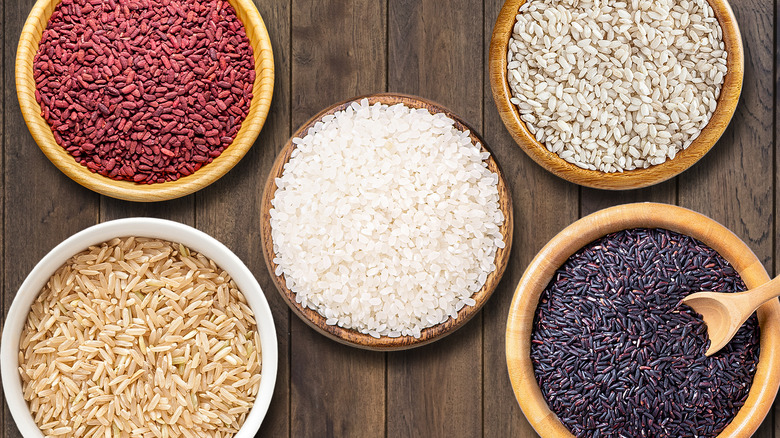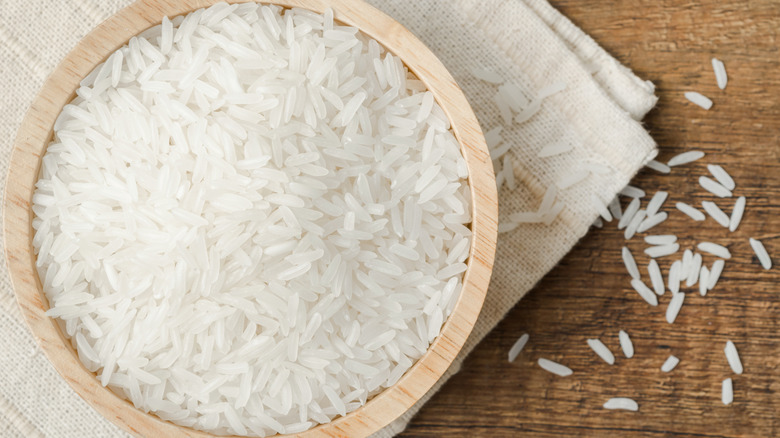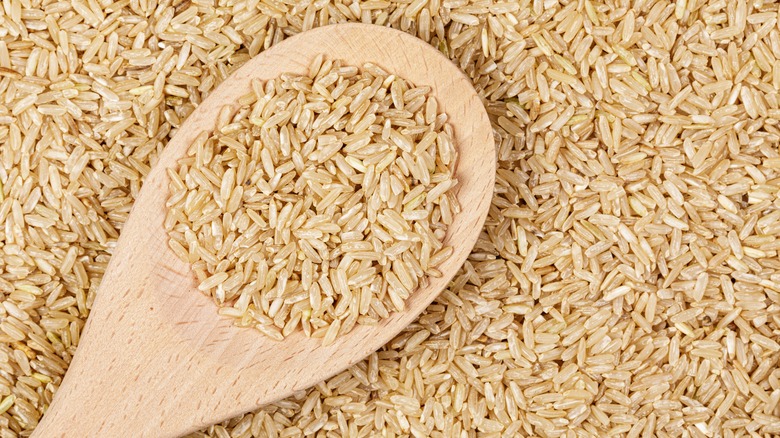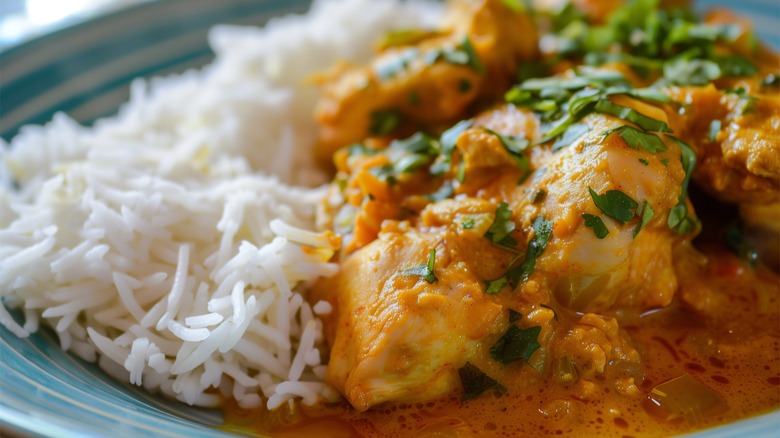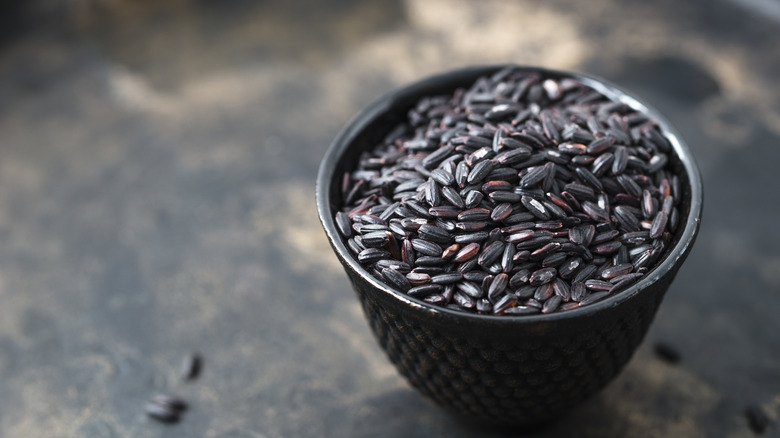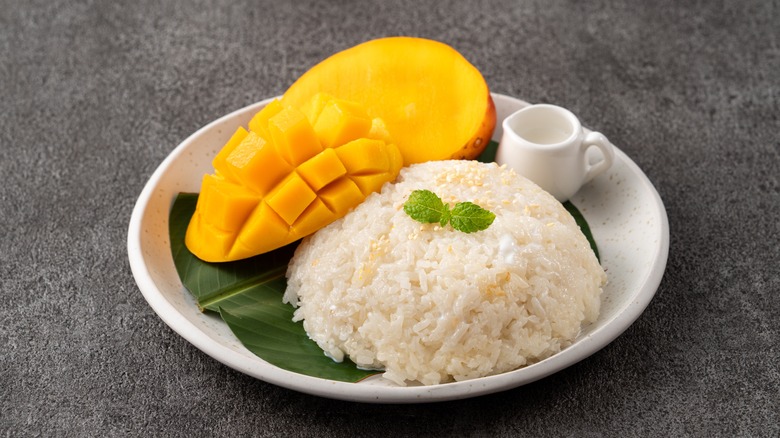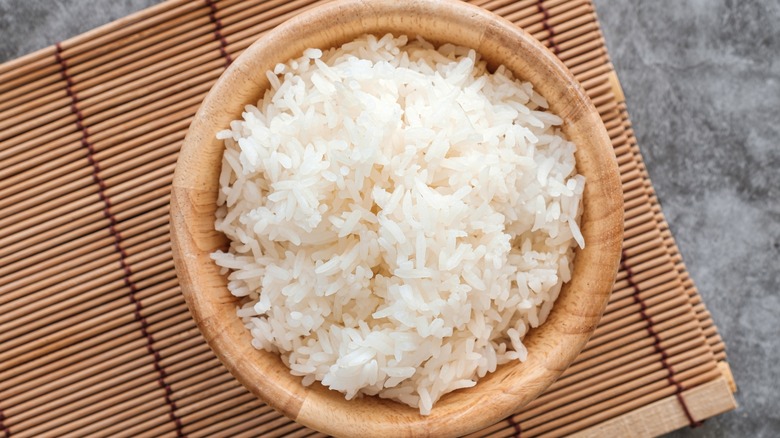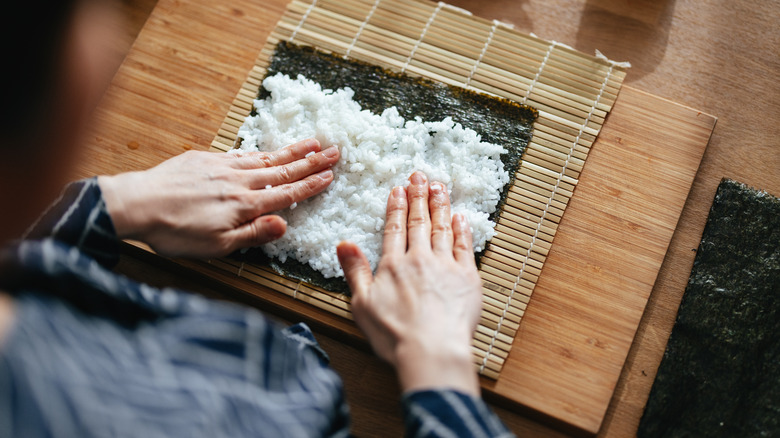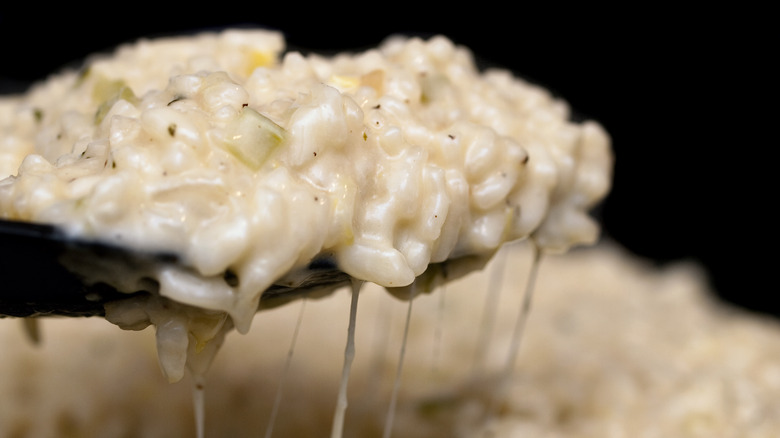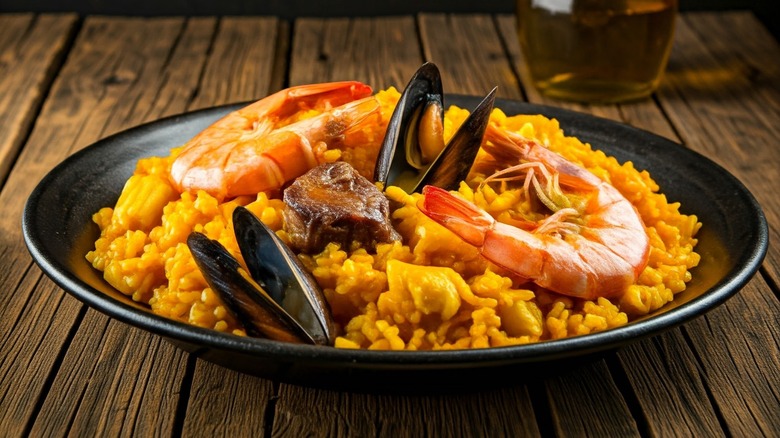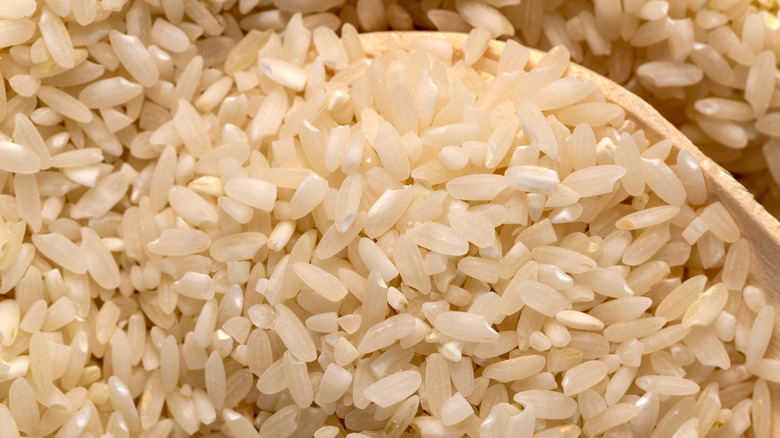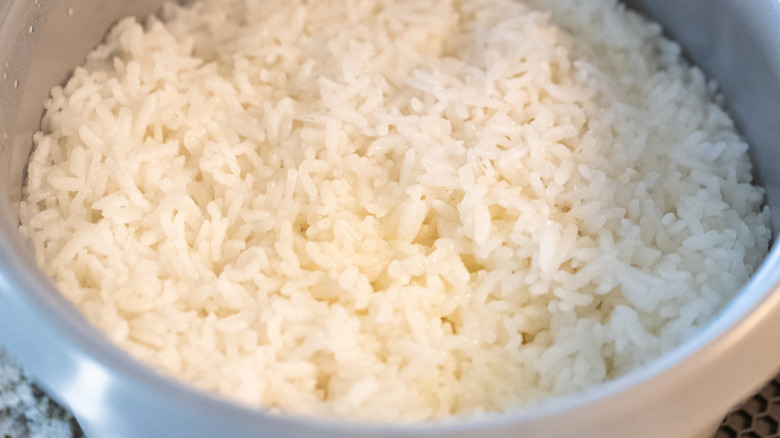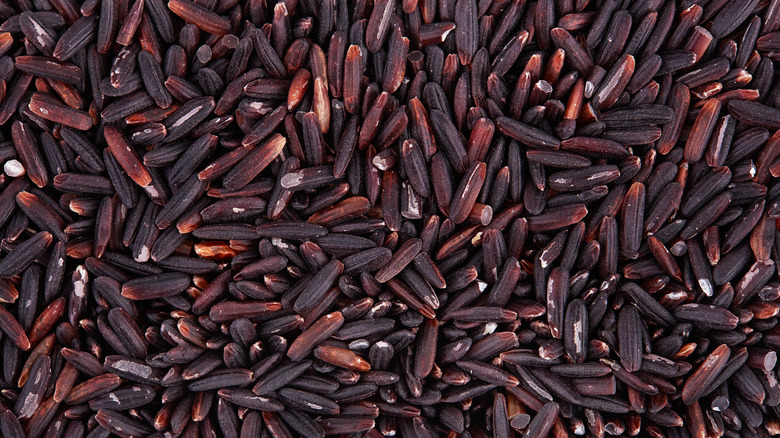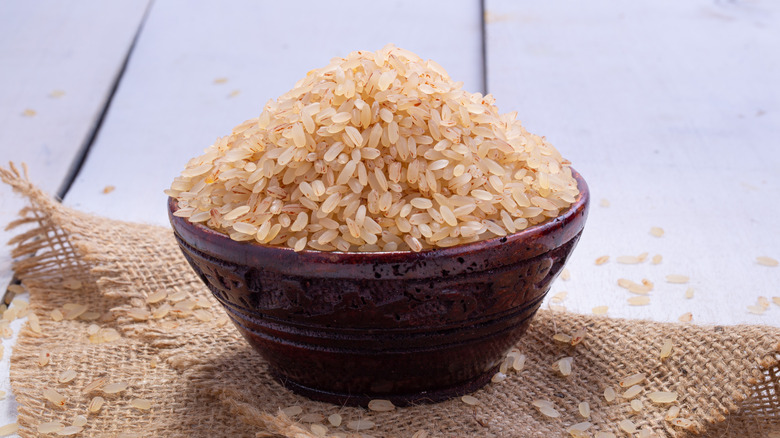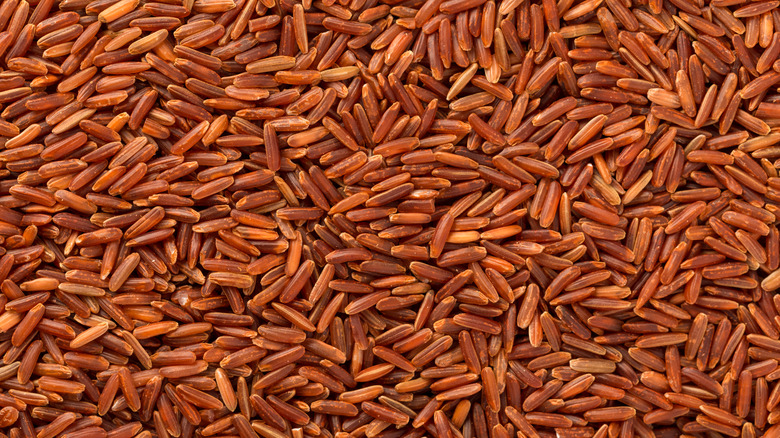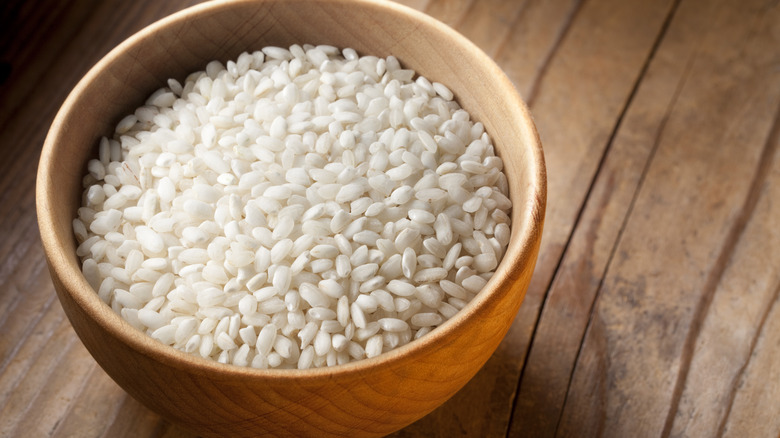15 Types Of Rice, Explained
Rice has to be of the most versatile and essential grains there is. As the third most produced grain worldwide after corn and wheat, it makes up a substantial part of diets around the globe. But, did you know, this humble grain comes in thousands of different varieties? If you tend to stick to the classic white or brown rice in your cooking, it might be time to branch out. There's a whole world of other rice variants to explore, offering a range of unique flavors, textures, and uses in the kitchen.
From fluffy, fragrant basmati rice to the subtle, nutty sweetness of red rice, each type has distinct characteristics such as grain length, starch content, color, and aroma, making it best suited to specific dishes and cuisines. Sticky rice pairs perfectly with chopsticks, while Arborio rice's creaminess shines in a classic Italian risotto. The diversity of rice offers seemingly endless possibilities in cooking, and learning how different varieties can fit into your everyday cooking is key. So, let's run through 15 of our favorites, covering their origins, unique qualities, nutritional differences, and the very best ways to enjoy them.
White rice
White rice is a classic staple that the majority of us have in our pantries. One of the most common and widely consumed types of rice, its mild flavor, soft texture, and easy digestibility make it a favorite. White rice goes through a refining process where the bran, husk, and germ layers are removed, leaving behind only the starchy white interior. This refinement gives it a longer shelf life and a lighter, fluffier texture when cooked, but does also remove some of the rice's nutritional value. However, many manufacturers of white rice enrich their products with essential nutrients, including iron and B vitamins, in an attempt to preserve its nutritional appeal.
Quicker to cook than many other types of rice, this variety makes a great base for various dishes, from curries and stir-fries to rice pudding. It's amazing at absorbing other flavors, too, so simple techniques like boiling the rice in broth, or stirring though some butter and herbs can completely transform its taste. White rice can also be further split into different varieties, usually categorized by grain length — short, medium, or long. Each grain type has specific cooking qualities: long-grain white rice tends to stay fluffy and separate, while short-grain white rice has a stickier, more compact texture.
Brown rice
This variety is a whole grain rice that retains its nutrient-rich outer layers, unlike white rice, which has these removed. This nutrient retention gives brown rice its characteristic nutty flavor, chewy texture, and light brown color. Brown rice also offers more nutritional benefits than its refined counterpart, making it a favorite amongst health-conscious consumers.
Rich in fiber, eating brown rice can aid digestion and help you feel satiated for longer, as well as promoting heart health. It's also packed with vitamins and minerals like calcium, magnesium, and phosphorus which are essential for various bodily processes. Unlike white rice, brown rice has a low glycemic index, and therefore won't cause any dramatic spikes in your blood sugar. In fact, consistently choosing brown rice over white could reduce your chances of developing type 2 diabetes.
Cooking brown rice requires slightly more time and liquid compared to white rice, and the result is a grain with a firmer, heartier texture. Its nutty taste often makes it the rice of choice in grain bowls, salads, and pilafs, where it adds a pleasant bite. Brown rice may not work as well in dishes requiring a sticky or delicate texture, but it certainly shines as a wholesome, nutrient-dense alternative to the classic white grain.
Basmati rice
With a distinctively fragrant aroma and delicate, nutty flavor, basmati rice is a quick-cooking, long-grain variety that's especially popular in South Asian cuisine. Basmati grains are slender and elongated in shape, and available in both brown and white forms. This rice is often cooked using the pilaf method to enhance it's aromatic flavor. This involves first sautéing the rice in a neutral oil, alongside ingredients like onion and garlic, before adding the cooking liquid.
One of basmati rice's standout features is its unique texture. When cooked, its grains stay separate and don't stick together, which gives the rice a particularly light and fluffy texture. Basmati actually doubles in size during cooking, whilst maintaining a delicious tender texture. Its floral fragrance adds a wonderful flavor to any dish it accompanies, from spicy curries to simple sides. You may also recognize it as the main component of the classic Indian rice dish — biryani.
Brown basmati varieties contains more fiber and nutrients, and offers a richer, nuttier flavor. Whilst the white variety loses some of its nutritional value during the refinement process, it does tend to have a lighter, fluffier texture. Whichever you choose, both will provide an excellent source of folate, thiamine, and selenium.
Black rice
Black rice can certainly be deemed the most striking variety of them all. It has a deep purple-black color, which comes from high levels of anthocyanins — a type of antioxidant that's also found in blueberries and blackberries. This ancient grain, originally cultivated in Japan, was once considered so precious that it was reserved solely for royalty, hence why it's sometimes referred to as "forbidden rice."
This variety has a slightly fruity flavor with a hint of natural sweetness. When cooked, its bold color intensifies further, so it's an excellent ingredient for adding some drama to your plate. Its texture is somewhat chewy, similar to brown rice but slightly more tender, so despite its unusual appearance, it's actually pretty versatile. You'll see black rice used in everything from rice bowls and stir-fries, to salads, and even desserts like rice pudding.
Being a whole grain variety, black rice makes a healthful choice, too. As well as being packed with free radical-busting antioxidants, it also contains the carotenoids lutein and zeaxanthin, which help to keep our eyes healthy. Black rice is higher in both fiber and protein than brown rice.
Sticky/glutinous rice
A firm favorite for many, sticky rice has a moreish texture that gives it its name. This short-grain variety contains high levels of a starch called amylopectin, which gives it that uniquely sticky, almost glue-like texture post-cooking. Though it's sometimes also referred to as "glutinous rice", sticky rice is naturally gluten-free. "Glutinous" here refers to its stickiness, not its gluten content. This rice has a mild, subtly sweet flavor that pairs well with both savory and sweet flavors, allowing it to complement a wide range of dishes from steamed dumplings to sweet rice cakes.
Popular in East and Southeast Asian cuisines, it's essential for dishes like Thai mango sticky rice, rice puddings, and Chinese zongzi (rice dumplings wrapped in bamboo leaves). The sticky texture of this rice, and the way the grains clump together with ease, make it ideal for eating with chopsticks and for forming into balls or other shapes. Unlike many other rice types, sticky rice is usually steamed rather than boiled, to maintain its characteristic consistency.
Jasmine rice
Jasmine rice is often likened to basmati rice, with both being long-grain varieties and having similarly fragrant and aromatic qualities. However, jasmine rice possesses plenty of its own unique characteristics. With a floral scent and soft texture, this rice is the grain of choice for a range of specific dishes, such as Thai curries and Chinese fried rice. Unlike basmati rice, which remains fluffy and separate, jasmine rice has a bit more stickiness, which gives it a comforting, tender texture. Taste-wise, jasmine is also a little sweeter, with a somewhat buttery taste.
The versatility of jasmine rice makes it a popular ingredient in Thai, Vietnamese, and Pakistani cuisines. It does an excellent job at absorbing rich flavors, with the rice's delicate aroma subtle enough not to overwhelm the taste of other components in the dish. A delicious way to prepare jasmine rice is by adding some canned coconut milk and a pinch of salt to the cooking liquid, which really helps to amp up its sweet, aromatic taste.
Sushi rice
A short-grain Japanese rice with a distinctly sticky texture, sushi rice has all of the qualities you'd need to create a perfectly formed sushi roll. Thanks to its high starch content, this rice is sticky enough to hold its shape — perfect for creating nigiri, maki rolls, and other bite-sized creations that need to stay intact. Its short grains cook up tender and slightly chewy, providing a super satisfying mouthfeel. Though similar in texture to sticky rice, sushi rice is an altogether different variety. In terms of starch content, sushi rice contains about 80% amylopectin, compared to sticky rice's 100%.
The preparation of sushi rice requires some crucial steps to achieve the optimum taste and texture. Prior to cooking, it must be rinsed thoroughly to remove excess starch and stop it becoming overly gummy. Once cooked, sushi rice is typically seasoned with a mixture of rice vinegar, sugar, and salt, giving it a slightly tangy, sweet flavor that serves as the perfect base for seafood and veggies.
Arborio rice
A staple in Italian cooking, Arborio rice is a short-grain, oval shaped rice that's most commonly used for whipping up a creamy risotto. Named after the town of Arborio in Northern Italy, where it was first cultivated, this rice variety has a relatively high starch content. Once cooked, this results in a wonderfully velvety texture, without being overly sticky.
The rich, comforting consistency of Arborio rice is what makes it shine as the main component of a risotto. It has a slightly firm, chewy center, and this al dente quality balances perfectly with its creaminess. When stirred during cooking, Arborio releases starch that thickens the dish, resulting in that signature luxurious feel. It's a rice that's perfect for absorbing the flavors from broths, cheeses, herbs, and spices. Since it doesn't have a tendency to go mushy, Arborio rice is well-suited to other creamy dishes, too, like rice puddings and soups. This rice is also typically used to make arancini — seasoned balls of rice and cheese that are coated in breadcrumbs and deep-fried.
Bomba rice
Paella is another rice-based dish that's loved by many foodies, and it tends to feature a specific variety of this grain. Bomba rice is what's most commonly reached for — a Spanish short-grain rice that's popular in Valencian cuisine. Like Arborio rice, bomba rice has the ability to absorb vast amounts of liquid without becoming mushy. In paella, it soaks up the savory flavors of saffron, seafood, meats, and vegetables in the broth, all whilst maintaining a pleasantly firm texture.
Bomba rice grains are short and round with a plump, hearty appearance. When cooked, they increase in both width and length pretty significantly. In fact, the name "bomba" actually translates to "bomb" in Spanish — referring to the way the grains appear to expand almost explosively upon cooking! Though most famous for its use in paella, bomba rice features in a range of other traditional Spanish dishes. To make arroz blanco, the rice is typically boiled in a mixture of broth, water, and garlic, whilst the colorful arroz con pollo features bomba rice cooked with a range of flavorful aromatics, vegetables, and chicken.
Carolina gold rice
Carolina Gold rice is an heirloom, long-grain rice, with deep roots in American history and agriculture. This variety was first brought from Africa and Indonesia to the Carolinas in the late 1600s, where it soon became central to the economy. Carolina Gold is described by many as having an unmatched flavor and texture, with a slight stickiness and notes of hazelnut.
By the late 18th century, Carolina Gold was cultivated on over 100,000 acres and exported globally, setting high standards for long-grain rice quality. However, after the Civil War and the Great Depression, its popularity waned, and it nearly disappeared. Remarkably, in the 1980s, Dr. Richard Schulze revived Carolina Gold by replanting seeds obtained from a USDA bank, and eventually with the help of food historian Glenn Roberts, brought Carolina Gold back to prominence. Today, it is cultivated organically across the Southeastern United States, restoring this iconic rice to its historical home.
This unique and richly flavored rice is sure to enhance any dish it features in, pairing beautifully with a range of meats and veggies. Its nutty flavor fits well in salads, pilafs, casseroles, and even risottos.
Calrose rice
Calrose rice is a medium-grain rice variety developed in California in the 1940s, making it a relatively new addition to the rice scene. This rice is soft and mild in flavor, so it's great for soaking up broths and sauces. In terms of stickiness, Calrose offers a happy medium, being less cohesive than varieties like sushi rice or sticky rice, but more so than standard white, brown, or basmati rice. The medium grains do still hold together well, so Calrose can even be used in dishes that require shaping of the rice, like sushi and rice balls.
This rice takes about 30 minutes to cook when boiled in water or broth, with 20 minutes of simmering, and 10 minutes of resting. Though it can complement a wide range of other ingredients and dishes, Calrose rice has become a favorite in Middle Eastern cuisine. It's used to make the classic Egyptian rice side dish, which includes fried vermicelli noodles for extra crunch.
Wild rice
If you're looking to experience some new flavors in your rice explorations, wild rice is one to try. This unique grain is native to North America, particularly in the Great Lakes region, and has a distinct appearance, taste, and texture. Despite its name, wild rice is not technically rice, but the seed of a semi-aquatic grass from the genus Zizania. Despite this, it can be prepared in the same way as other forms of rice. Wild rice has dark, slender grains with a chewy texture and a grassy, smoky taste that sets it apart from other rice varieties.
As well as its appealing color and flavor, wild rice is often selected by chefs and home cooks alike due to its exceptional nutritional value. This variety contains more protein and fiber levels than most types of rice, and has up to 30 times the antioxidant levels of standard white rice. Wild rice's distinct taste and hearty texture make it an excellent standalone side dish, though it pairs well with other earthy flavors like mushrooms and nuts. It is, however, likely to set you back a little more than common rice varieties. Due to wild rice's meticulous harvesting methods, which are often done by hand, it's painfully pricy. But many retailers sell wild rice mixed with other types of rice like basmati, which allows you to enjoy the benefits of this unique grain whilst bringing down the cost a little.
Matta rice
Matta rice (also known as Kerala red rice or rosematta rice) is another lesser-known variety, with an exotic appearance and unique taste. The grains, which are a light reddish brown in color, offer an earthy flavor and plenty of nutritional benefits. Its signature shade comes from the bran layer, which is retained in the processing, locking in a good dose of fiber as well as essential nutrients like iron and magnesium. Matta is therefore a fantastically wholesome option.
When cooking brown rice, it takes a little longer for matta rice grains to become tender, though the process can be sped up by using a pressure cooker. Once cooked, it will be soft and fluffy, with plump, rounded grains that aren't too sticky. Though not as commonly used as other varieties in Western cooking, matta rice is popular in Indian and Sri Lankan cuisine. It's served both as a side, and used to make other dishes like idli — a type of savory rice cake and appam — a thin rice and coconut pancake often served with curries and stews.
Red rice
A rice variety with a deep reddish brown color, red rice gets its distinctive hue from its antioxidant-rich bran layer. Like black rice, red rice contains anthocyanins, which have anti-inflammatory and anti-cancerous properties. It will also provide you with greater amounts of fiber and protein than white rice.
The term red rice can actually refer to a number of different varieties, with the most common being West African rice, Bhutanese red rice, and Thai red rice. Each has its own nuances in taste in texture, but the flavor generally leans towards being nutty and sweet, with the mouthfeel being slightly chewy. Red rice can either be whole grain, with the nutritious bran and germ layers retained, or partially milled, where just some of the bran stays intact.
This rice can be used much like brown rice, pairing well with roasted vegetables and salads. It can also be layered in grain bowls or cooked with aromatics and diced vegetables as a simple side dish. Red rice requires rinsing before cooking, and will take 30-40 minutes to reach optimum tenderness.
Carnaroli rice
Similar to Arborio rice, Carnaroli rice is an Italian, medium-grain variety that can yield a rich, creamy texture whilst remaining al dente in the center. While Arborio is more common, many chefs would argue that Carnaroli offers a superior texture and consistency, resulting in an even creamier and more luxurious risotto.
This rice has a slightly shorter and thinner grain than Arborio, and due to its higher amylose content, it holds its shape better during the slow, gradual cooking process risotto requires. Though it can be more challenging to find and slightly more expensive than other risotto rices, it would seem that Carnaroli is worth the investment for its quality and texture, perhaps best reserved for special occasions!
It's the consistent stirring and gradual addition of liquid that causes Carnaroli rice to release starch and become wonderfully creamy in a risotto, but you can also simply boil this rice for a lighter, fluffier finish. Just give it a rinse, and pop it in a pan of simmering water for about 15 minutes.
